Samsung Galaxy S8 Showdown: Exynos 8895 vs. Snapdragon 835, Performance & Battery Life Tested
by Matt Humrick on July 28, 2017 8:00 AM EST- Posted in
- Smartphones
- Samsung
- Galaxy
- Mobile
- SoCs
- Snapdragon 835
- Exynos 8895
- Galaxy S8
System Performance
Now that we have a better understanding of how the Galaxy S8’s two SoC options perform, it’s time to see how well the S8’s hardware and software work together. To evaluate overall system performance, we turn to the PCMark Work 2.0 suite, which tests the combined effects of the CPU, GPU, RAM, and NAND storage. Because it uses standard Android API calls and runs several different real-world workloads that elicit realistic behavior from the CPU governor (unlike synthetic tests that simply run one or more CPUs at max frequency), it’s a good indicator of everyday performance.
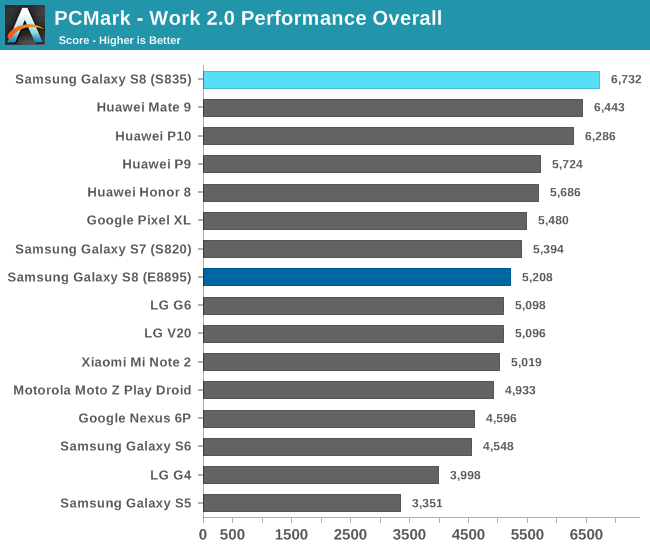
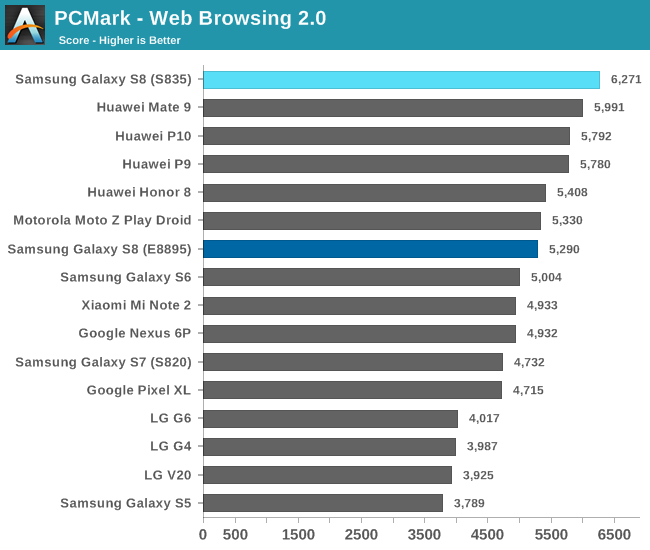
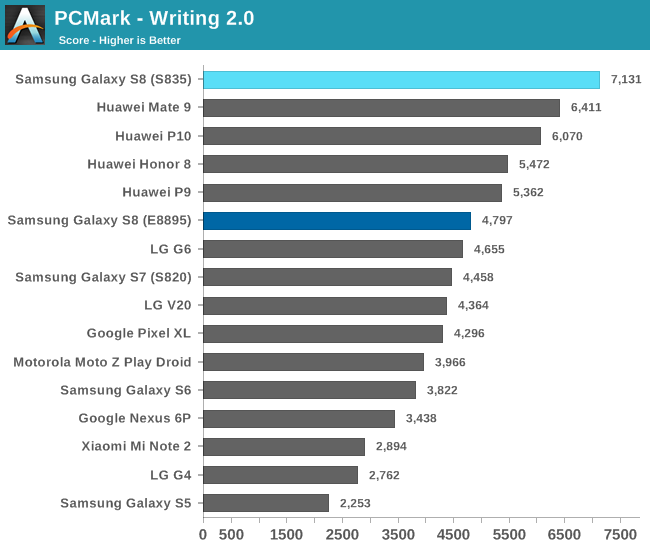

Right away we see a very noticeable difference in overall performance between the two different S8 versions. The S8 with Snapdragon 835 tops the chart, scoring better than the previous champion, the Huawei Mate 9, and outpacing the Exynos 8895 version by 29%. Not only is the E8895 S8 slower than its brother, it also fares no better overall than the older Galaxy S7 (S820). Both S8’s are faster than the Galaxy S6, however, with the S835 version scoring 48% better overall and the E8895 version squeaking past with a 15% margin. Compared to the Galaxy S5 and its S801 SoC, the S8 is 100% and 55% faster, respectively.
In the Web Browsing test, the hierarchy at the top half of the chart is largely the same, although the performance deltas are less than what we saw for the overall PCMark scores. The S835 S8 claims the top spot once again and outperforms its E8895 counterpart by 19%. The Galaxy S8 (S835) and Galaxy S5 bracket the results, with the former showing a 66% advantage. The Exynos S8 is a little slower than the Snapdragon version (19%), but is at least faster than all the previous Galaxy phones by as much as 40% relative to the S5. LG phones typically do not perform as well in this test because threads spend more time running on the lower-performing A53 or efficiency CPU cores compared to other phones, presumably a deliberate decision by LG to reduce power consumption.
The Galaxy S8 (S835) delivers the best performance in the Writing test, whose workload elicits frequent, short bursts of activity from the big CPU cores. Our previous testing showed little difference in integer IPC between the S8’s two SoCs, but the S835 model performs 49% better than the S8 with E8895. The primary difference between the two models is how the scheduler migrates threads between the small and big CPU clusters. With the E8895, Samsung is a bit more conservative with moving threads onto the M2 cores. Both S8s are faster than the LG G6 and all the phones using a Snapdragon 820 SoC, though. The S8 is also between 2x and 3x faster than the Galaxy S5.
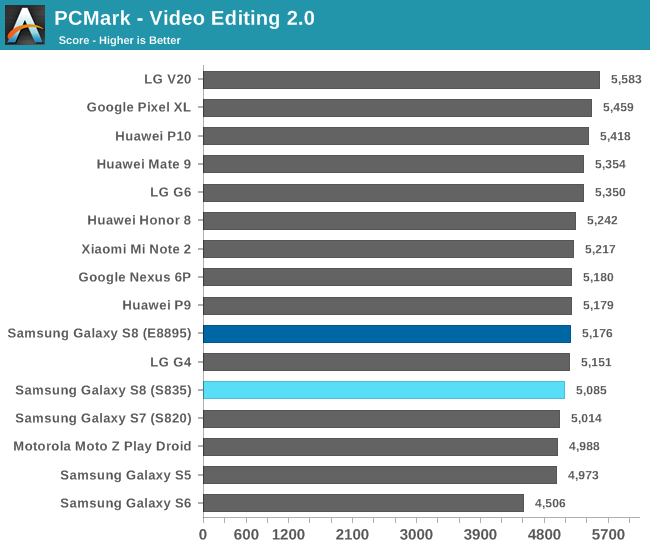
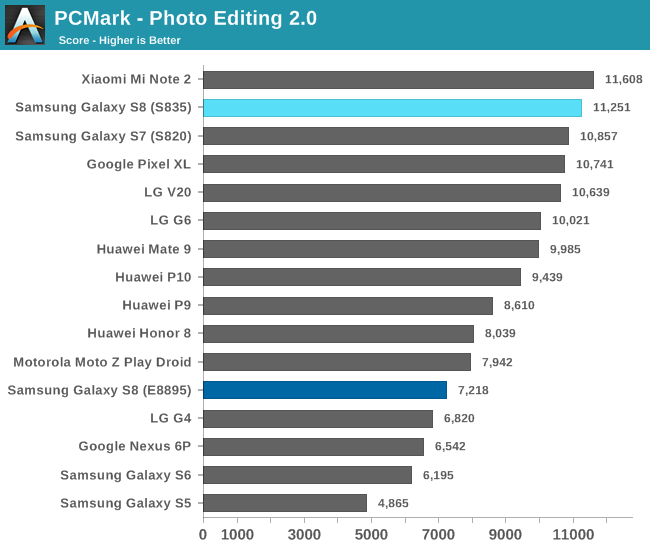
The Video Editing test’s workload is not very strenuous, so we do not see much performance variation; however, the Photo Editing test, which applies a number of different photo effects and filters using both the CPU and GPU, shows more interesting results. Qualcomm’s Adreno GPUs stand out here by combining strong ALU performance with driver optimizations. The Galaxy S8 (S835) sits among the phones using S820/S821 at the top of our chart, all sitting above the Mate 9, which is the first phone in this group to use an ARM Mali GPU. Compared to the E8895 model, the S8 (S835) performs 56% better. Curiously, the S8 (E8895) and its 20-core Mali-G71 GPU is considerably slower than the Mate 9’s 8-core Mali-G71 when running this workload.

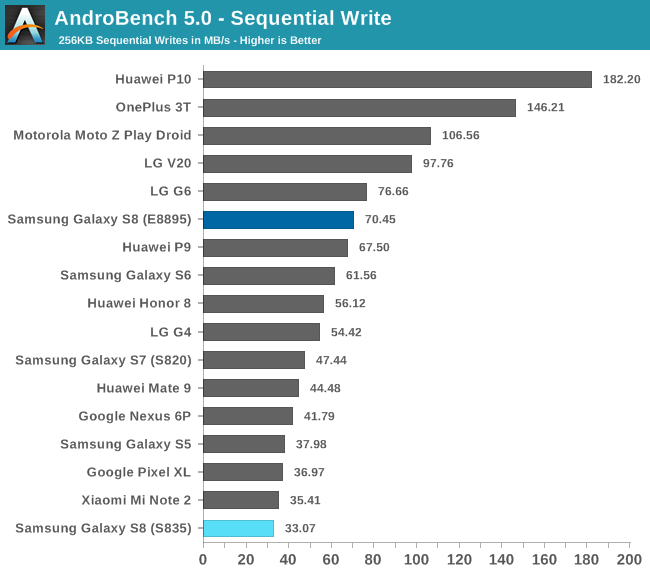
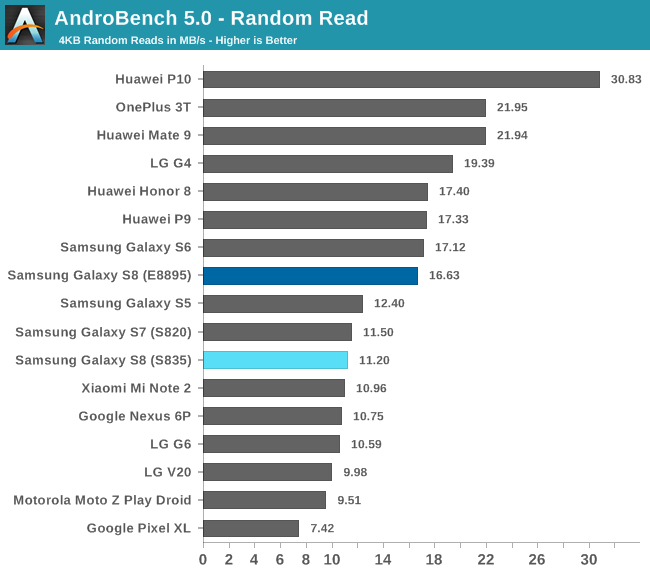
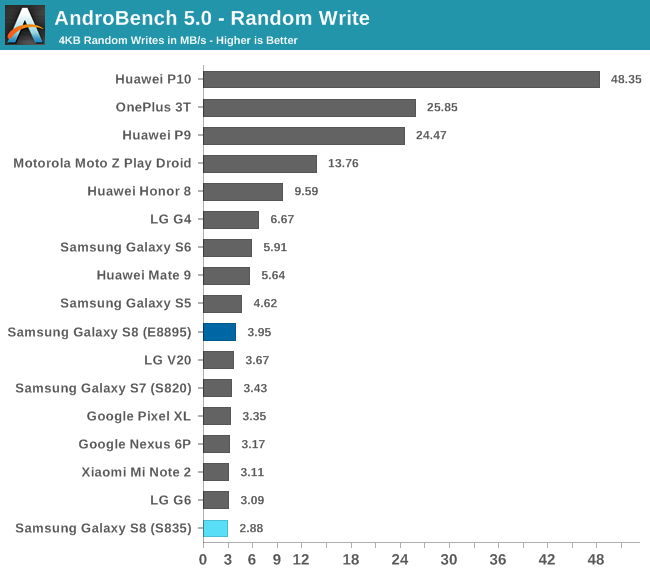
* Note: The OnePlus 3T and Huawei P10 may be using an unpatched version of the F2FS filesystem that artificially inflates write performance.
It’s common to source NAND from multiple vendors, a practice forced into the spotlight this year with NAND chips in short supply. Earlier this year, Huawei took some heat after customers began complaining of poor storage performance in its top-tier Mate 9 and P10 phones. Huawei admitted that it was using lower-performing components due to supply shortfalls, with some customers claiming they received eMMC NAND instead of UFS.
Unfortunately, even Samsung, which is one of the major NAND suppliers, is not immune to this dilemma, sourcing NAND from at least two suppliers for the Galaxy S8. Our E8895 S8 uses Samsung UFS 2.1 NAND and performs about 2x faster in the sequential read and write tests than our S835 S8 that uses UFS 2.0 NAND from Toshiba. The S8’s (S835) write performance, both sequential and random, is particularly poor. This is not necessarily a deal breaker, however, because read performance has a greater impact on user experience.
| Storage Performance (AndroBench 5.0) | ||||||||
| Seq. Read (KB) |
Seq. Write (KB) |
Random Read (KB) |
Random Write (KB) |
|||||
| 1024 | 2048 | 1024 | 2048 | 8 | 16 | 8 | 16 | |
| Galaxy S8 (S835) | 320.91 | 388.53 | 66.55 | 90.41 | 21.26 | 37.29 | 5.53 | 6.90 |
| Galaxy S8 (E8895) | 583.66 | 674.02 | 101.31 | 136.19 | 32.16 | 64.59 | 7.00 | 12.62 |
| Galaxy S7 (S820) | 275.80 | 324.24 | 90.52 | 115.43 | 19.76 | 39.65 | 5.76 | 10.56 |
| Huawei P10 | 499.35 | 541.97 | 55.73 | 96.00 | ||||
| LG G6 | 314.68 | 346.02 | 102.62 | 112.12 | 19.24 | 37.37 | 5.87 | 10.84 |
* Note: The Huawei P10 write values are crossed out because they likely are not accurate.
The table above shows how storage performance scales with larger IO sizes. While the values we use in our general tests above represent the most common IO sizes, other workloads, notably accessing media files like photos and video, will utilize larger IO transfers, so it’s important to see how a phone performs over a wider range of scenarios.
Throughput generally increases with IO size, and this is certainly true for the S8 (E8895), whose sequential read speed reaches 674 MB/s for 2 MB transfers, surpassing even the speedy P10. Performance for the S8 (S835) scales too, but its write performance remains consistently lower than other flagships; however, at larger IO sizes its throughput surpasses the Galaxy S7 (S820) when reading from storage.
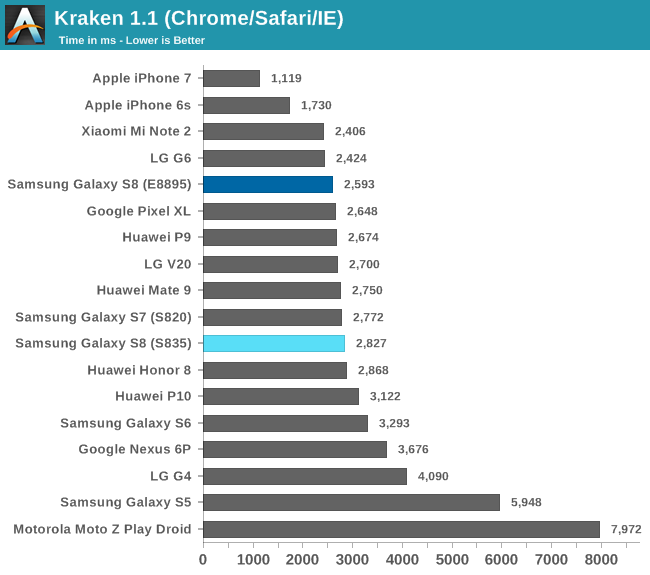
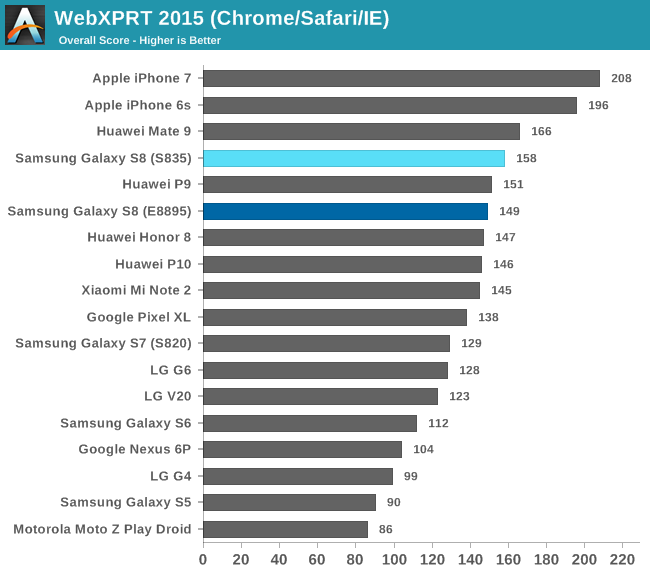
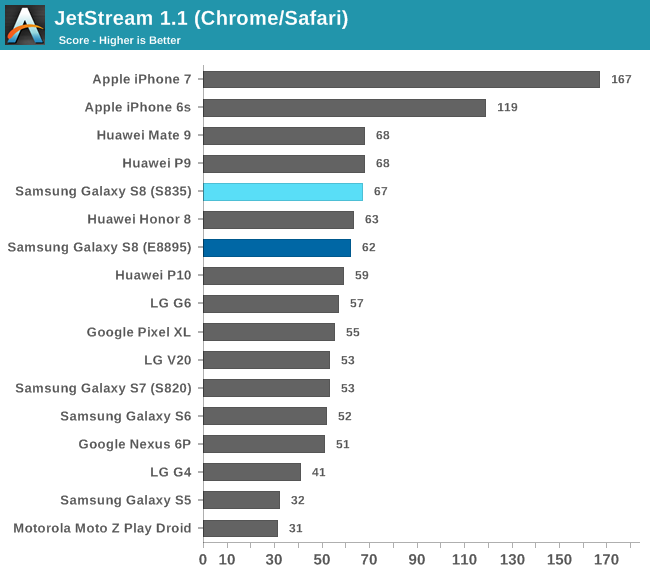
In the JavaScript tests, both the E8895 and S835 versions of the Galaxy S8 perform similarly, with their scores differing by no more than 8%. This is not surprising considering how close the M2 and Kryo 280 CPUs are in peak frequency and integer IPC. Both S8’s perform well relative to other flagship phones (all of which had the latest updates applied and were running Chrome 57), but do not distinguish themselves as the fastest currently available.
At the other end of the scale, the Galaxy S5 manages to outperform the Moto Z Play Droid (S625) and its octa-core A53 CPU configuration. The S8 offers a much faster browsing experience, of course, not just for JavaScript but also page rendering and scrolling, outperforming the S5 by an average of 2.1x in these three tests.
The Galaxy S8 performs well overall, but isn't consistently leading the pack and thus unable to cleanly establish itself as the premiere flagship in terms of everyday performance. The S835 model, despite its poor write performance, is clearly the faster of the two models when using real-world apps. I did not have much of an opportunity to use the E8895 S8 since it was a time-limited loaner, but the user interface of the S835 model remains quite fluid while swiping and scrolling through the home screen, app drawer, recent apps menu, Edge panel, and browser. The S8 (S835) is the fastest and most fluid feeling Galaxy phone I’ve ever used.










137 Comments
View All Comments
goatfajitas - Friday, July 28, 2017 - link
/edit - buy what suits youzodiacfml - Friday, July 28, 2017 - link
It is not that big. The "taller" aspect ratio exaggerates the diagonal. To the article, the 10nm SoC now seems more valuable than benchmarks/reviews I've seen from other sites. Since the Pixel is going to be expensive, taller, no storage expansion and without a headphone jack, I have no ideal phone yet this year. The Mi Mix 2 or the LG V30 might.philehidiot - Saturday, July 29, 2017 - link
Just as a side point, I went from a HTC M9 to an S8. I tried and tested the S8 and S8+. Bear in mind I have small hands to the point where I also pack a pair of socks to compensate. If you're American or not quite so crude that means I prefer a 9mm to a .45. I found the elongated screen of the S8 to be just about tolerable and the advantages for multitasking do outweigh the occasional situation where I need to reach the far end of the screen and can't do it. I suspect most people with normal hands will find the S8 to be perfectly fine from a usability standpoint. Certainly the S8+ I would strongly recommend you try a live model before you buy and perhaps consider waiting for the new Note if big screens are your bag.As for the carrying something that big you haven't heard the worst of it. It's well built - teardowns show this. Equally it's still made of glass for crying out loud. You NEED a case (and what's the point in making something so aesthetically amazing when you have to cover it??!!) and not a light one either. I have a leather fold out case which allows me to watch stuff on the phone at an angle and also takes some cards. Interestingly, it has two magnets right next to where the cards live. I got locked out of my hotel room due to this. Regardless, the necessary beef and size of case required to protect such a fragile device means the size is doubled. If HTC had continued down the metal line I'd have gone with them but it's all about bloody glass these days and I'm sick of it.
Tttimothy2355 - Friday, July 28, 2017 - link
Apple stocks galaxy awesomesyxbit - Friday, July 28, 2017 - link
>>"Our initial look at Snapdragon 835 revealed that its Kryo 280 performance cores are loosely based on ARM’s Cortex-A73 while the efficiency cores are loosely based on the Cortex-A53"Why would you write such a blatant lie. It's not LOOSELY based at all. It's >95% the same chip. QCOM have made minor tweaks just to be able to market it as their own design.
tipoo - Friday, July 28, 2017 - link
Where would the A10 fall on the ratio/GHz chart I wonder?http://images.anandtech.com/graphs/graph11540/sams...
name99 - Friday, July 28, 2017 - link
We can guess.You can see the A9 results here:
http://www.anandtech.com/show/9686/the-apple-iphon...
Eyeballing it, they are on average about 1.5x the current A73 results.
A10 results are about 50% faster again, while running at the same frequency as the CPUs referenced in the article, so basically about twice the IPC of the current A73 crop of champions.
One thing that stands out in comparing the SPEC results across all these devices is the massive jump in 175.vpr. A9 (which, like I said, is at around 1.5x for most results) has a value of 2017. This is about in line with what we see for Snapdragon 821. Then we get these massively (2x larger than I'd expect) scores for the other high-end ARM cores.
My guess is that something changed in the compiler in the past year or so. (Since the article doesn't say whether gcc or llvm was used, I can't investigate further.) My guess is likewise that this wasn't something nefarious, some "cheat" to make SPEC results look better --- no-one cares about SPEC2000 on ARM64 anyway --- but rather some general improvement in the compiler (perhaps loop unrolling/data placement, but most likely autovectorization) that managed to MASSIVELY improve ARM64 performance on this particular piece of code.
Presumably (if the change is in LLVM...) Apple picks up the same improvement, but sadly we never got to see the A10 SPEC results. Maybe A11?
So summary
- Apple's IPC seems to now be at around 2x ARM competitors for most purposes. (It's at around 1.25x Intel's; but to be fair Intel can clock higher; but to be fair Intel uses more juice)
- something interesting happened to 175.vpr on ARM64 in the past year or so, and if anyone knows, they should speak up!
Nullify - Saturday, July 29, 2017 - link
I was hoping for Anand to do a deep dive on the A10. Perhaps they're saving it for the A11? Should be the first ARM core in the world to break 4,000 single core on Geekbench, making it a full 2X faster than the 8895 or 835. It's truly amazing how much further ahead Apple is.tuxRoller - Saturday, July 29, 2017 - link
How big are those some cores, again?It's not like this is magic, and these companies know his to make very high IPC if you don't care about cost. Apple has built a massive core, and they pay the price in silicon.
ARM, and most of their licensees, are optimizing for silicon area efficiency, not absolute performance.
http://cdn.wccftech.com/wp-content/uploads/2016/10...
Meteor2 - Saturday, July 29, 2017 - link
I think that, as alluded to above, Android and iOS are diverging so much that there's little point comparing Apple IPC to ARM or whoever, you may as well compare it to Power or SPARC.